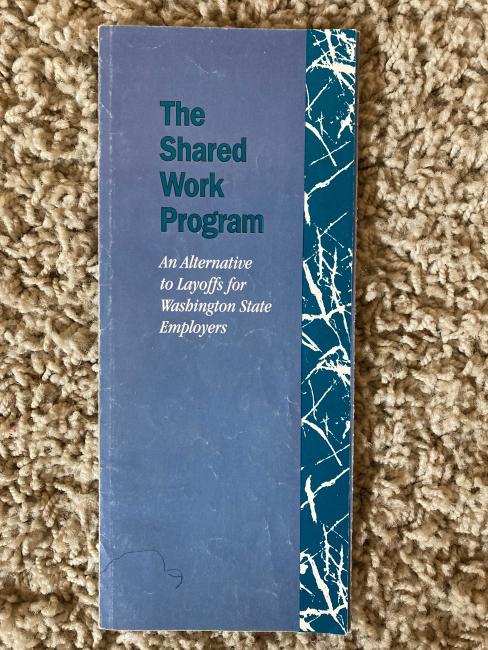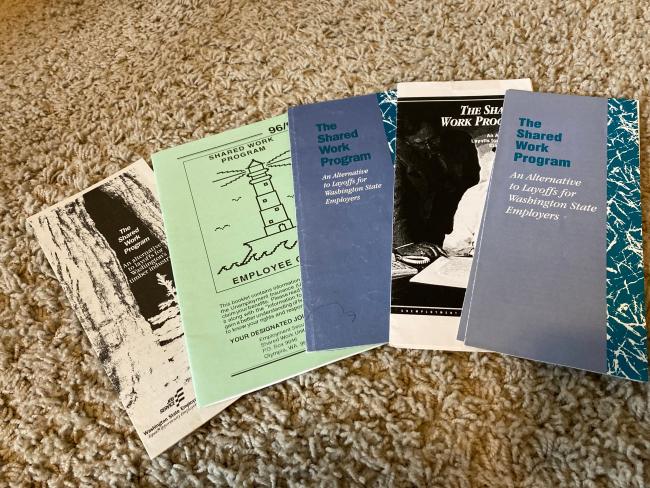Released on
In 1983, the Motorola DynaTAC 8000x — touted as the world’s first portable cellular phone — was gearing up to launch in the United States.
The device, which took about 10 hours to charge and provided 30 minutes of talk time, would cost users nearly $4,000 when it hit shelves a few months later in 1984. Including its antennae, the phone was more than 14 inches long.

That same year, Washington state’s Employment Security Department was also gearing up to unveil something new: a short-term compensation program to help
employers and employees navigate an unsteady economy.
Enacted into state law in 1983, the SharedWork program was designed to help employers who were anticipating or experiencing a temporary slowdown and do not want to lay off their employees.
In essence, the state program — then and now — allows employees to keep their jobs and benefits. It also saves employers money and keeps their workforce intact. Participating SharedWork employees receive wages when they work, and unemployment benefits for the hours they do not.
In June 2023, SharedWork celebrated its 40th anniversary. Although the world has changed significantly since that first cellphone went on sale, the program still offers the same benefits to employers and employees that it did back when the program began.
More than four decades later, SharedWork continues to serve Washingtonians by helping employees return to work more quickly. It saves employers money by lowering their payroll costs, and their unemployment insurance taxes do not rise as quickly as they would if they were doing full layoffs.
'SharedWork has given employers flexibility when they need it,' ESD Commissioner Cami Feek said. 'It’s remarkable. The program has withstood the test of time for decades and it’s something I’m really proud of. It helps employers and employees when they’re most vulnerable. And it’s been doing that for 40 years.'
But there’s room for improvement. As of April 2023, only about 1,000 employers participated in SharedWork, while more than 103,000 Washington employers are eligible.
Many employers continue to face layoffs and uncertainty as they attempt to retain employees and remain profitable.
It was a similar situation in the late 1970s and early 1980s, when a slowing economy caused businesses to tighten their collective belts. Massive layoffs ensued, so much so that it caused one state’s legislature to do something drastic.
A new program in California takes hold
In 1978, Sen. Bill Greene introduced Senate Bill 1471 to the California State Legislature as part of a federal pilot program. When the bill passed, it established the nation’s first short-term unemployment compensation program.
Green, representing Los Angeles, was described by a friend as being 'very pro-labor and pro-business. He was able to mix the two without antagonizing either group,' according to his obituary published in the Los Angeles Times in 2002.
A 1982 pamphlet touted the benefits of California’s Work Sharing Unemployment Insurance (WSUI) program as 'the first program of its kind in the nation and one which offers Californians increased flexibility of work style.' The state’s Employment Development Department said it was committed to providing employers with information about reduced work-time options during times of layoffs.
'Faced with greater financial cutbacks and adverse business conditions, we realize the need for more flexible work arrangements, and we are eager to assist employers with any alternative work styles that will keep people in the California work force.'
A survey conducted by California Employment Development indicated that 'more than 90% of workers who had participated in the program were in favor of keeping it.'
Word was spreading, and not just to California employers.
Work-sharing programs take off in other states
Oregon and Arizona added work-sharing programs in 1982, shortly before Congress signed temporary legislation that allowed states to develop work-sharing legislation. The legislation was called the Tax Equity and Fiscal Responsibility Act, and authorized states to use their trust fund money to pay for work-sharing arrangements, also known as short-time compensation.
A USA Today article from December 1982 described California’s legislation for work sharing as a 'model for all subsequent bills.'
Washington unveils its own program
In the early 1980s, Washington state faced its own economic challenges.
Local aerospace company Boeing Co. was laying off thousands of employees, prompting legislators to 'search for ways to keep workers attached to local companies in a downturn,' according to a 2012 story in the Vancouver Columbian.
Legislators introduced Substitute Senate Bill 3087 to provide 'greater flexibility in the payment of unemployment compensation benefits in situations where qualified employers elect to retain employees at reduced hours rather than instituting layoffs.'
Gov. John Spellman signed the bill into law on May 16, 1983.
According to a memo dated June 1983 — one month after Washington’s program began — employers had been 'very good at spreading the word about this program.' It was a good sign for the new program, which was ramping up during a national recession. According to a report from the Bureau of Labor Statistics, unemployment rates were shooting up at a higher rate than at any time since World War II. By the end of 1982, the unemployment rate would reach double digits for the first time since 1941.
California had touted that the program had possible use 'as an anti-recession measure,' according to a news release in 1980. So, it was only natural for Washington and other states to investigate similar methodology.
On July 21, 1983, the Washington State Employment Security Department announced its SharedWork Program, enacted during the recent session of the state legislature, would be available for employers on Aug. 1. The announcement came from ESD Commissioner Norward Brooks, according to a news release.
Employers who use this program as an alternative to reducing their workforce are better prepared to gear up quickly when the economy recovers, Brooks said. They are also spared the expense of recruiting, hiring and training new employees.
Just like today, employers must have a plan approved by ESD.
Washington among states that paved the way
By 1983, the U.S. Department of Labor sent out instructions for setting up short-time compensation programs, effectively providing a blueprint for states to use when forming their own programs.
By 1992, 18 states had work-sharing programs. Similarities and differences emerged across these states, according to a 1992 U.S. Department of Labor report to Congress.
The report found some key takeaways:
· Employer participation was low, although for unknown reasons.
· Employers who used short-time compensation programs were generally satisfied, and many employers who used the program did so repeatedly.
· Despite use of the programs, layoffs remained the primary way employers reduced their workforce.
SharedWork helped employers weather the Great Recession
In 2009, SharedWork helped over 2,100 Washington employers weather the Great Recession and keep almost 41,000 people employed. That year, Washington ranked №2 in the country behind California in terms of number of businesses and employees using the program, according to a Seattle Times story.
By 2012, SharedWork was serving more than 2,400 employers. When surveyed, 70% of those who responded said SharedWork helped them survive the recession, and 99% said they would recommend the program to other businesses.
Following the success of SharedWork during the Great Recession, Congress offered to have the federal government cover most of the cost of short-term compensation benefits from July 2012 through June 2015.
Over 3,500 Washington employers used SharedWork during the pandemic
When the global COVID-19 pandemic sent workers home to quarantine, Washington’s SharedWork program kept many businesses going.
Between March and August 2019, just under 700 businesses took part in SharedWork. In 2020, when COVID-19 sent many employers scrambling to keep their doors open after sending their workers home,
that number grew to more than 3,500 in Washington, according to an August 2020 New York Times article.
This coincided with the federal government’s weekly $600 supplemental job benefit for people receiving unemployment insurance benefits.
'We would have been forced to lay off people and work with more of a skeleton crew,' said Whitney Grisaffi, president of Tacoma-based Ted Brown Music, in the article. 'This saved us a whole lot of jobs.'

SharedWork still helping businesses, employees after all these years
More than 40 years later, SharedWork still helps employers protect their businesses and retain workers.
The program offers free webinars in English and Spanish that aim to help employers who have not applied for the program and would like to know more. Often these webinars include information about other programs, such as the Paid Family and Medical Leave, Unemployment Insurance tax
and wage reporting, WA Cares, the Work Opportunity Tax Credit and federal bonding programs.
'SharedWork is a vital program that makes such a big difference for employees, employers and the community,' Program Supervisor Cheryl Brown said. 'I’ve worked in this program for more than 20 years and I’ve seen how it can really help people. We’re proud that this program has been in place since 1983 and we hope it’s around for decades to come.'
To learn more about SharedWork, go to sharedworkwa.com.

